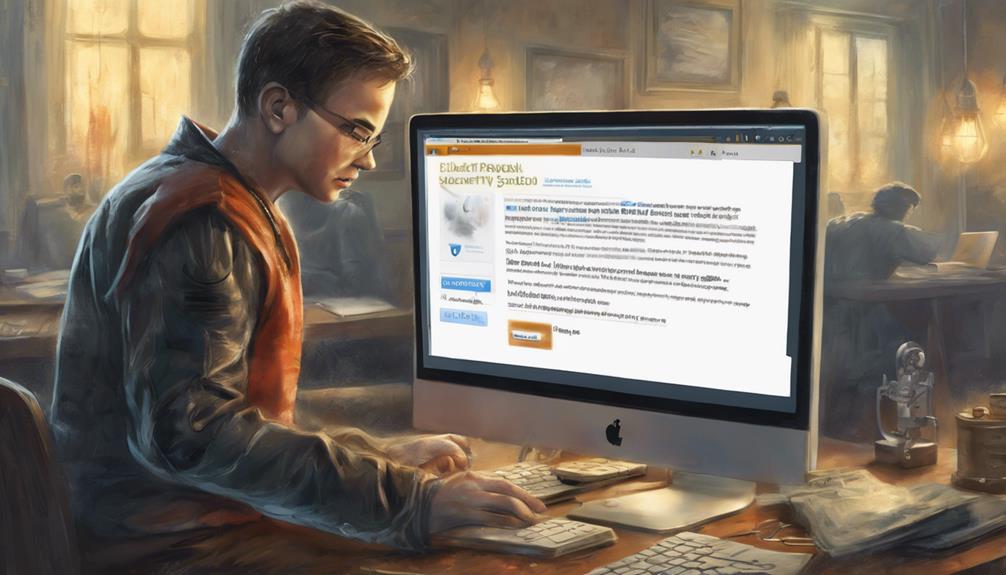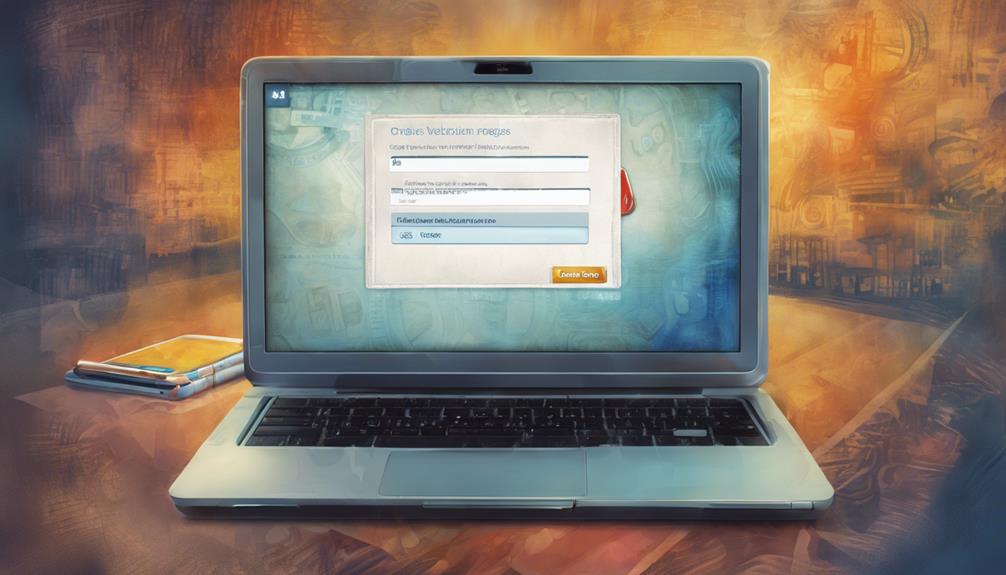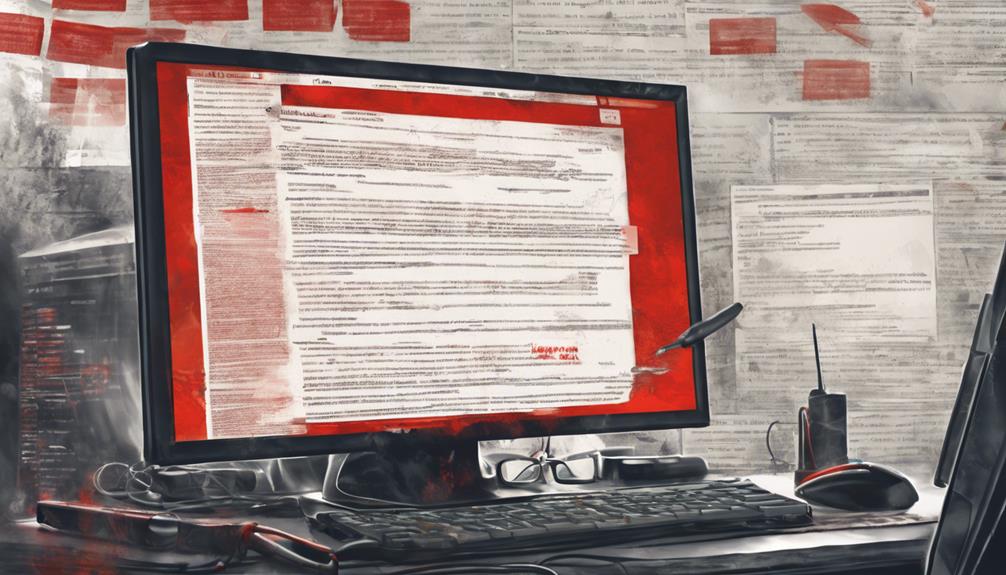To safeguard your Hotmail account from hackers, establish strong password practices, utilize HTTPS encryption, update password information regularly, and be cautious of phishing attempts. Implement two-factor authentication, monitor login activity, and maintain awareness of suspicious emails. Regularly check and update security measures to mitigate risks. By prioritizing password security, HTTPS encryption, and ongoing vigilance, you enhance protection against potential threats. These practices form a robust defense against hacking attempts on your Hotmail account, ensuring a secure online experience. For a deeper understanding of safeguarding your Hotmail account, explore the outlined security strategies provided.
Key Takeaways
- Utilize strong, unique passwords with special characters for Hotmail.
- Enable HTTPS encryption for secure data transfer on Hotmail.
- Implement two-factor authentication for added account security.
- Be vigilant against phishing attempts targeting Hotmail accounts.
- Monitor and report any suspicious activity to Hotmail promptly.
Importance of Strong Passwords
In safeguarding online accounts, the importance of using strong passwords cannot be overstated. When it comes to Hotmail passwords, opting for a combination of uppercase and lowercase letters, numbers, and special characters creates a robust defense against potential hackers.
Utilizing unique passwords for each account further enhances security, as it prevents a breach on one platform from compromising others. Weak passwords make it easier for malicious actors to decipher and access accounts, putting sensitive information at risk.
To reinforce account security, Hotmail users should refrain from using easily guessable passwords such as 'password123' or common phrases. Implementing strong password policies, including regular password changes and avoiding password reuse, can greatly reduce the likelihood of unauthorized access.
Additionally, enabling features like two-factor authentication adds an extra layer of protection to Hotmail accounts, making them more resilient against potential cyber threats. By prioritizing the creation and maintenance of strong, unique passwords, Hotmail users can safeguard their accounts effectively.
HTTPS for Secure Connection

Hotmail employs HTTPS encryption to safeguard the transfer of data between users and its servers, ensuring that information remains confidential and secure. This protocol plays a critical role in protecting against malicious hackers who may attempt to intercept sensitive data, such as login credentials, during transmission.
Users can easily verify the presence of a secure connection by checking for the HTTPS protocol in the browser's address bar when accessing their Hotmail accounts.
HTTPS Encryption Explained
Utilizing HTTPS encryption plays a crucial role in maintaining the security of data transmitted between users' devices and email servers like Hotmail.
HTTPS, which stands for Hypertext Transfer Protocol Secure, establishes a secure connection between your browser and the Hotmail servers, ensuring that sensitive information such as login credentials and emails are encrypted for protection against potential hackers.
This encryption mechanism encrypts the data exchanged between your device and the email servers, greatly reducing the risk of interception by malicious actors.
It is imperative to always verify a secure connection when accessing Hotmail by checking that the URL in your browser starts with 'https://'.
By implementing HTTPS encryption, Hotmail enhances data protection measures, safeguarding user accounts from potential hacking attempts.
Essentially, HTTPS encryption is a fundamental component in upholding the confidentiality and integrity of data transmitted through the Hotmail platform.
Secure Data Transmission
To enhance the security of data exchanged between users and email servers like Hotmail, the use of HTTPS encryption for secure connections is essential. Hotmail guarantees secure data transmission by encrypting the communication through HTTPS, preventing hackers from intercepting sensitive information during transit.
It is important for users to always connect to Hotmail using HTTPS to safeguard their data and protect against potential hacking attempts. By utilizing HTTPS, Hotmail adds a layer of security that makes it harder for hackers to access user data or login credentials.
Especially when accessing Hotmail on public computers, using HTTPS enhances security by encrypting the transmitted data, thereby reducing the risk of hacking incidents. The encrypted connections provided by HTTPS play an important role in maintaining the integrity and confidentiality of data exchanged on Hotmail, ensuring a safer user experience.
Protection Against Hackers
Implementing HTTPS encryption provides a vital safeguard against hackers attempting to intercept sensitive data transmitted through email servers like Hotmail. By enabling HTTPS when accessing Hotmail, users can establish a secure connection that encrypts the data exchanged between their devices and Hotmail's servers.
This encryption adds an essential layer of protection, making it much harder for hackers to eavesdrop on communications or steal valuable information such as login credentials. Utilizing HTTPS on public computers is especially important as it can prevent unauthorized access and potential data breaches that may compromise user accounts.
Hotmail users can rely on HTTPS encryption as a standard security measure to enhance the safety of their email communications and shield themselves from hacking attempts. In a digital landscape where cybersecurity threats are prevalent, leveraging HTTPS demonstrates a proactive approach to safeguarding sensitive data and maintaining the confidentiality of online interactions.
Updating Password Reset Information

Maintaining up-to-date password reset information is essential for ensuring the security of your Hotmail account against potential hacking threats. By regularly updating your password reset details, you facilitate easy access to your account in case of unauthorized access attempts.
Hotmail relies on this information to verify your identity, protecting your personal information from falling into the wrong hands. It is imperative to heed Hotmail's prompts to review and update your password reset options regularly, as neglecting this task could result in difficulties regaining access to a compromised account.
Ensuring that your password reset information is accurate and up-to-date is a proactive measure in safeguarding your Hotmail account from malicious hackers. Remember, the security of your account lies in the hands of the precautions you take, making the maintenance of your password reset details a critical aspect of your overall online security strategy.
Using HTTPS on Public Computers

Utilizing HTTPS on public computers enhances the security of accessing Hotmail by encrypting data transmission, thereby safeguarding sensitive information from potential hackers.
When using public computers to log into Hotmail, it is important to enable the HTTPS protocol for secure communication. Here are three key reasons why HTTPS is essential on public computers:
- Data Encryption: HTTPS guarantees that the data exchanged between the user and the Hotmail server is encrypted, making it notably harder for hackers to intercept and decipher sensitive information.
- Protection on Public Wi-Fi Networks: Public Wi-Fi networks in places like cafes or libraries are often targeted by hackers due to their vulnerabilities. Enabling HTTPS adds a layer of protection against potential threats lurking on these networks.
- Safeguarding Login Credentials: Enabling HTTPS on public computers helps protect essential information like login credentials from being exposed to malicious actors, reducing the risk of unauthorized access to your Hotmail account.
Enabling Two-Step Verification

Enabling two-step verification greatly enhances the security of your Hotmail account by requiring an additional authentication step beyond just entering a password. This two-factor authentication method adds an extra layer of protection by prompting you to enter a code or approve a notification on a trusted device before granting access to your account.
By implementing two-step verification, you adopt one of the best security practices to safeguard your Hotmail account against unauthorized access. Even if a hacker manages to obtain your password, this feature ensures that only you can access your account, reducing the risk of hacking considerably.
It is highly recommended to enable two-step verification to enhance the overall security of your Hotmail account and protect your sensitive information from potential threats. Strengthening your account with this additional security measure is a proactive step towards fortifying your online presence and maintaining the confidentiality of your emails and personal data.
Avoiding Phishing Attempts

To bolster the security measures discussed in enabling two-step verification, it is imperative to understand the significance of avoiding phishing attempts when using your Hotmail account. Phishing attempts are a common method used by hackers to gain unauthorized access to your email account and potentially compromise sensitive information.
Here are three key practices to help you steer clear of falling victim to such scams:
- Avoid clicking on links in suspicious emails: Refrain from clicking on any links in emails that appear dubious or claim to be from Hotmail, especially if they prompt you to provide personal information or login credentials.
- Be cautious of requests for sensitive information: Hotmail will never ask for your password or financial details via email. If you receive such requests, it is likely a phishing attempt, and you should avoid sharing any confidential information.
- Verify the sender's legitimacy: Check the sender's email address for any anomalies like spelling errors or unusual formatting. If the email seems suspicious, refrain from interacting with it and consider reporting it as a phishing attempt.
Monitoring Login Activity
Effective vigilance over login activity is vital for enhancing the security of your Hotmail account against unauthorized access. By monitoring your login activity, you can keep track of when and where your account has been accessed, allowing you to detect any suspicious login attempts promptly.
This feature enables users to identify any unauthorized logins from unfamiliar devices or locations, providing an early warning system against potential hacking incidents. Hotmail also offers the option for users to sign out of all devices, adding an extra layer of security in case of unauthorized access.
Regularly checking your login activity not only helps in preventing unauthorized access but also allows for a swift response to any security breaches that may occur. This proactive approach to monitoring login activity is essential in safeguarding your Hotmail account from malicious hackers seeking unauthorized access.
Being Wary of Suspicious Emails

Vigilance in identifying and handling suspicious emails is essential for Hotmail users to protect their accounts from potential hacking threats. Phishing emails are a common tactic used by hackers to deceive individuals into disclosing their Hotmail login credentials.
These deceptive emails often contain links to counterfeit login pages designed to mimic the official Hotmail site, aiming to trick users into revealing sensitive information. To shield their Hotmail accounts from such threats, users should exercise caution and follow these guidelines:
- Avoid Clicking Links: Refrain from clicking on links embedded in emails from unknown sources or those that appear suspicious.
- Beware of Attachments: Do not download any attachments from emails that seem questionable, as they could contain malware or phishing attempts.
- Report Suspicious Activity: If you receive a suspicious email requesting personal information or login details, report it to Microsoft immediately to help protect other Hotmail users from falling victim to phishing scams.
Regular Security Checks

Hotmail's dedication to security is evident through its regular security checks, which encompass encryption, firewalls, and proactive monitoring for any signs of suspicious activities. These measures are vital in safeguarding user accounts from potential hacking threats.
Microsoft's continuous investment in cutting-edge security technologies further reinforces the protection of Hotmail accounts.
Security Measures Overview
Implementing consistent security checks is essential for maintaining the safety of Hotmail accounts against potential hacking threats. When it comes to securing your Microsoft account, there are several key measures to take into account:
- Utilize Two-Factor Authentication: Enabling two-factor authentication adds an extra layer of security to your Hotmail account. This feature requires not only a password but also a second verification method, such as a code sent to your phone, making it harder for hackers to gain unauthorized access.
- Guarantee HTTPS Encryption: Hotmail employs HTTPS encryption to secure data transmission between your device and the email server. Always make sure that you are accessing your account via HTTPS, especially when using public computers, to prevent interception of sensitive information.
- Regularly Update Password Information: Keeping your password reset information up to date can facilitate easy recovery in case of a hacking incident. It is advisable to use complex and varied passwords to enhance the security of your Hotmail account and deter hacking attempts.
Vulnerability Assessment Results
Regularly conducted vulnerability assessments provide critical insights into potential weaknesses in Hotmail's security infrastructure. These assessments entail thorough testing of security controls to pinpoint any vulnerabilities that could be exploited by hackers.
By periodically conducting these assessments, Hotmail can guarantee that its security settings are robust and effective in safeguarding user data. The results obtained from these vulnerability assessments play a pivotal role in guiding security enhancements and implementing necessary changes to prevent hacking incidents.
It is imperative for Hotmail to engage in continuous monitoring and assessment to uphold its defenses against potential security breaches. Users are also advised to proactively take measures such as changing their passwords regularly and enabling two-step verification to enhance the security of their Hotmail and Google accounts.
Keeping Software Updated

To enhance the security of Hotmail accounts, maintaining up-to-date software is essential in protecting against potential vulnerabilities and security threats. Updating software regularly is imperative for safeguarding against known software vulnerabilities that hackers exploit to access online accounts.
Here are three key reasons why keeping software updated is essential for Hotmail security:
- Patch Weaknesses: Regular updates address software vulnerabilities that hackers could use to breach Hotmail accounts. By promptly applying patches, users can mitigate the risk of security breaches and unauthorized access to sensitive information.
- Reduce Risk: Outdated software increases the likelihood of security breaches, making Hotmail accounts more susceptible to hacking incidents. Updating software promptly helps reduce the risk of security compromises and enhances overall account security.
- Enhanced Protection: Hackers often target outdated software with known vulnerabilities to infiltrate systems. Keeping software updated provides enhanced protection against these malicious attempts, fortifying the security of Hotmail accounts and reducing the likelihood of security breaches.
Frequently Asked Questions
Can My Hotmail Account Get Hacked?
Your Hotmail account can be vulnerable to hacking due to various methods like phishing or weak passwords. Implementing strong password practices, staying vigilant, and utilizing security features provided by Hotmail can help protect your account.
Can Hotmail Be Trusted?
Hotmail can be trusted due to its robust security measures, continuous investment in safeguarding user accounts, two-step verification, regular password changes, and strong password requirements. Utilizing HTTPS encryption and updating recovery information further enhance its trustworthiness.
How Do I Make My Hotmail Safer?
To enhance Hotmail security, users should employ strong passwords, enable two-step verification, maintain updated password reset information, avoid public computers or unsecured networks, and monitor account activity for suspicious behavior. Promptly report any concerns to Hotmail support.
Is Gmail or Hotmail More Secure?
When comparing Gmail and Hotmail security, user habits play a pivotal role. Gmail's end-to-end encryption gives an edge in data protection. Hotmail's robust security measures are effective if users maintain good practices like two-step verification.
Conclusion
In essence, it is essential to prioritize the security of your Hotmail account by following best practices such as using strong passwords, enabling HTTPS, and monitoring login activity.
One interesting statistic to note is that according to a report by Verizon, 81% of hacking-related breaches involved stolen or weak passwords.
By implementing these security measures, users can greatly reduce the risk of falling victim to hackers and protect their personal information.









